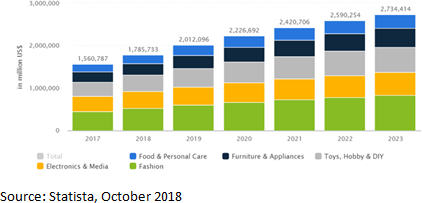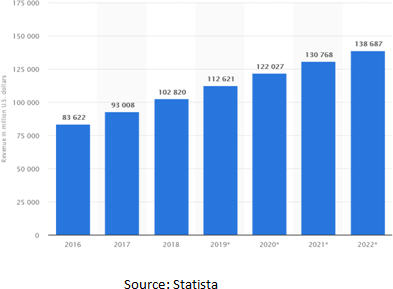During the end of the 18th century, manufacturing has undergone a transition
through industrialization with the introduction of water and steam powered
machinery. We now call this Industry 1.0. It was followed by the introduction of
electrically powered mass production machinery in the late 19th Century, which
would be referred to as Industry 2.0.
As technology developed and the needs of the consumers evolved, Industry 3.0 was
introduced in the late 1970s through more complex usage of electronics and
information technology and systems to further automate the production process.
In this way, companies were able to meet the increasing demands of the consumers
for accurate, high-quality, wide range of products in a speedy way.
For some years now, we are experiencing the transition towards Industry 4.0
where cyber systems, enhanced software, mechatronics and automation are the key
elements in the entire production life cycle.
When we look at the various processes involved in the textile and fashion
industry, the effects of Industry 4.0 can be seen starting at product design
through the usage of CAD systems, automated machinery in all aspects of
production and RFID tracking systems in logistics, warehousing and retailing.
In the textile and ready-to-wear industry, we see many applications all
throughout the production processes, such as virtual reality technologies used
in product design and communication between parties, 3D printing in prototype
and sample production to optimize time used, digital color management and
digital printing for flexibility and speedy response, robotic aids to transport
goods within the production facility, etc.
On the retail and consumer side, with the aid of digital platforms and data
centers, companies are able to collect data, and segment and analyze their
customers in a more effective way and present product and services that match
their requirements, thus gaining a competitive advantage over their competitors.
Our industry is already dominated with the fast-fashion cycle and production
companies are looking into ways of improving their speed to market as well as
attaining a specific level of quality. Through the automation of various
processes and the usage of artificial intelligence these targets are more
attainable and come at a lower cost. By using these technologies, companies can
reduce the amount of waste and defects occurred during production and increase
customer satisfaction.
It is evident that with each development and transition the complexity increases
incrementally. Therefore, it is not possible to talk about a complete transition
all at once. Companies need to analyze their current operations and identify
areas for improvement and development. They also need to take a close look at
their organizational structure and make gradual cultural changes and shift
towards a more technology-based one.
In today’s world, the needs and expectations of the consumer, their request for
speedy service and product, and simpler and user-friendly access to information
and product characteristics are increasing. In order to be able to keep up with
these increasing demands, companies need to focus their attention on constant
improvement of their operations.
But does this mean that every company has to digitalize all of their operations?
Or shall they adopt a phase by phase approach to transition into Industry 4.0?
This is a question that needs to be answered separately by each company. What is
concrete is that each company has to think about this transition and has to
create a Road Map for this transition if they want to keep up with the
everchanging technology and its implications.
~ ~ ~ ~ ~
E-COMMERCE AND FASHION
E-commerce is an essential part of today’s retail market. Globalization and
digital advancements have paved the way and global consumer trends have shaped
the e-commerce market from a small segment to a vital part of any brand’s
success.
Fashion industry makes up the largest segment of e-commerce revenues worldwide.
The industry has helped shape e-commerce sector as a whole and in turn also has
shaped itself according to the ever-changing needs of e-commerce.
Increasing e-commerce revenues and fashion leading the way
The share of e-commerce is steadily growing in total retail revenues; according
to eMarketer Report published in Jan. 2018 e-commerce sales made up 10.2% of
total retail sales worldwide in 2017, in contrast to 8.6% in 2016.
In 2017 e-commerce revenues were recorded at 1,560,787 million USD and Fashion
segment made up almost 29% of the total. According to Statista, the total market
is expected to grow with a CAGR of 8.9% from 2018 to 2023. Fashion segment is
expected to generate revenues of 524,871 million USD in 2018 and grow faster
than the total market with a CAGR of 9.8% from 2018 to 2023.


According to Statista, China has the largest e-commerce market with 740 billion
USD, followed by the US (560 billion USD), UK (93 billion USD), Japan (87
billion USD) and Germany (76 billion USD).
US is one of the biggest e-commerce markets in fashion and it is expected to
grow further in the near future. According to Internet Retailer Online Apparel
Report 2018, in the US online apparel sales made up 27% of total apparel sales
and 266 of the top 1000 online retailers were sole apparel retailers and this
figure excludes online retailers such as Amazon or Walmart. Macy’s is the
largest apparel retailer and 6th on the overall list.
The US Fashion e-commerce retail revenues were estimated to be 93 billion USD in
2017 according to Statista. The growth trend is expected to continue with
revenue estimates of 139 billion USD in 2022.
US Fashion and accessories e-retail revenue (2016-2022)

Fashion e-commerce to benefit both consumers and brands
E-commerce is an essential part of the consumption habits in clothing and
accessories. Fashion brands and consumers all benefit from e-commerce. Consumers
can browse through products, choose colors, learn about sizing, care and
composition, compare prices, read reviews and make their choices considering all
the possible alternatives. The e-commerce sites also enable the consumers to
contact the brand and companies with questions, returns and comments. When done
right, an e-commerce site for fashion retailers provides the perfect customer
service.
There are many benefits to fashion brands as well. E-commerce sites enable the
brands to follow the consumer preferences and buying patterns instantly and
provide useful data to further connect with the consumers. E-commerce also lets
brands test new markets with minimal initial investments.
There’s always room to grow more and be better in e-commerce
Main inducers for growth in e-commerce are increasing online access and
smartphone penetration. For fashion industry another factor influencing growth
is the variety of products and prices offered and the consumer experience
offered. Increase in sharing economy will also further induce growth in
e-commerce as marketplaces gain share.
In e-commerce the most important element is customer engagement; the consumers
look for visually attractive sites that provide a seamless shopping experience,
provide detailed information on the product and customized aspects for users. In
the fashion segment information on the sizes, fitting and product composition as
well as visuals from a 360 angle are vital.
Personalization is becoming even more important both in product offers and also
in promotions directed to the consumer. As e-commerce infrastructures can
provide data to the fashion brands on the consumer preferences and their
decision patterns, brands can analyze this data and come up with personal
recommendations or relevant online site architecture.
Needless to say, the technology behind e-commerce is also vital for success. The
download speed, quality of images, search engine and criteria all affect the
customer experience and the brand image in return.
Multi-channel management is another tool to increase e-commerce sales and
fashion brand sales in total. Companies can be offering sales through many
channels but omni-channel management, which defines how the multiple channels
are managed in synchronization is of greater importance. Offline stores,
e-commerce sites, marketplaces and social media all need to be working in
connection with each other to attract the consumer and turn the interest into a
buying pattern. Companies can measure clicks, analyze past purchases and
calculate the accuracy of their targeted promotions. It is important to
understand where the consumer’s decision to buy is made, be it social media,
offline store or e-commerce site, to efficiently serve the customer. For
example, if the decision to buy a certain brand or brand’s product is made on
social media, the e-commerce site needs to provide a quick check out instead of
showing more options.
Of course, another important factor for success is always following innovations
such as internet of things, image recognition, virtual fitting rooms, e-commerce
in offline stores, wearable technology and more.
It is easy to observe the success of e-commerce worldwide and estimates for
further growth are very clear. Many major fashion retailers worldwide are
investing on improving their e-commerce sales and some even estimate that a
third of their sales will be generated through e-commerce in the near future.
~ ~ ~ ~ ~
Back to top
WERNER LABOR COST COMPARISON 2018 - Request for Submissions
Once again, we are in the process of compiling a new set of
labour cost comparisons and you are invited to participate in this worldwide
study which is a useful tool utilized globally throughout the textile and
apparel industries.
The results will be published on our web site under the name
"WERNER LABOR COST COMPARISON 2018"
Your participation will guaranty that you will receive the study
before it is published.
Please contact Beth Govoni Marshall at bgovoni@wernerintl.com for
the form that may be filled out by someone in your payroll or accounting
department. We have tried to make the form as simple as possible so that only
the basic data is required.
Your data will be kept confidential.
~ ~ ~ ~ ~
Back to top

Management consultants to the world textile, apparel & fashion industry
Werner International is a management consulting practice specialized exclusively in the fiber, textile and fashion industry
globally active since 1939.
Werner’s services range from industrial and technology support
for setting-up, improving and restructuring
textile and clothing manufacturing operations
to strategy and marketing services for new market entry,
new product development, supply chain management,
branding, retailing, partner search
and future strategies build-up.
Werner is unique among world leading consulting companies
in being able to combine specialized expertise
in the technical areas with global marketing and
strategy know-how and supply chain integration.
Werner International, Inc.
13800 Coppermine Road
1st, 2nd, 3rd Floors
Herndon, VA 20171 USA
Phone + 1 703 871 3938
Fax + 1 703 871 3901
www.wernerinternational.com
info@wernertex.com
Copyright © 2019

